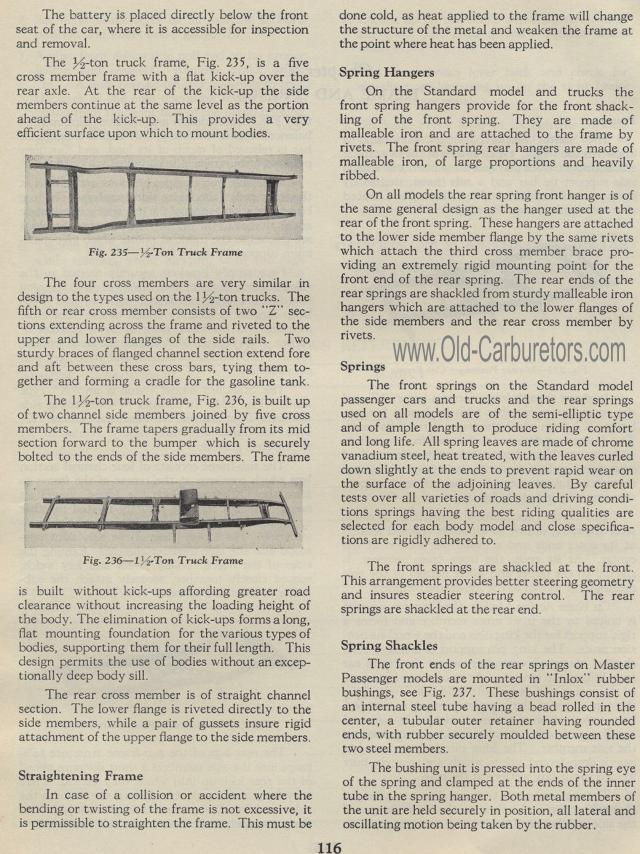Skip to: site menu | section menu | main content
The battery is placed directly below the front seat of the car,
where it is accessible for inspection and removal.
The 1/2-ton truck frame, Fig. 235, is a five cross member frame with a flat kick-up
over the rear axle. At the rear of the kick-up the side members continue at the
same level as the portion ahead of the kick-up. This provides a very efficient
surface upon which to mount bodies.
Ton Truck Frame
The four cross members are very similar in design to the types used on the 1M-ton trucks. The fifth or rear cross member consists of two "Z" sections extending across the frame and riveted to the upper and lower flanges of the side rails.
Two sturdy braces
of flanged channel section extend fore and aft between these cross
bars, tying them together and forming a cradle for the gasoline
tank.
The 1M-ton truck frame, Fig. 236, is built up of two channel side
members joined by five cross members. The frame tapers gradually
from its mid section forward to the bumper which is securely bolted
to the ends of the side members. The frame
Fig. 236— I 1/2 -Ton Truck Frame
is built without kick-ups affording greater road clearance without
increasing the loading height of the body. The elimination of kick-ups
forms a long, flat mounting foundation for the various types of
bodies, supporting them for their full length. This design permits
the use of bodies without an exceptionally deep body sill.
The rear cross member is of straight channel section. The lower
flange is riveted directly to the side members, while a pair of
gussets insure rigid attachment of the upper flange to the side
members.
Straightening Frame
In case of a collision or accident where the bending or twisting
of the frame is not excessive, it is permissible to straighten
the frame. This must be
done cold, as heat applied to the frame will change the structure
of the metal and weaken the frame at the point where heat has been
applied.
Spring Hangers
On the Standard model and trucks the front spring hangers provide
for the front shack-ling of the front spring. They are made of
malleable iron and are attached to the frame by rivets. The front
spring rear hangers are made of malleable iron, of large proportions
and heavily ribbed.
On all models the rear spring front hanger is of the same general
design as the hanger used at the rear of the front spring. These
hangers are attached to the lower side member flange by the same
rivets which attach the third cross member brace providing an extremely
rigid mounting point for the front end of the rear spring. The
rear ends of the rear springs are shackled from sturdy malleable
iron hangers which are attached to the lower flanges of the side
members and the rear cross member by rivets.
Springs
The front springs on the Standard model passenger cars and trucks
and the rear springs used on all models are of the semi-elliptic
type and of ample length to produce riding comfort and long life.
All spring leaves are made of chrome vanadium steel, heat treated,
with the leaves curled down slightly at the ends to prevent rapid
wear on the surface of the adjoining leaves. By careful tests over
all varieties of roads and driving conditions springs having the
best riding qualities are selected for each body model and close
specifications are rigidly adhered to.
The front springs are shackled at the front. This arrangement
provides better steering geometry and insures steadier steering
control. The rear springs are shackled at the rear end.
Spring Shackles
The front ends of the rear springs on Master Passenger models are
mounted in "Inlox" rubber bushings, see Fig. 237. These
bushings consist of an internal steel tube having a bead rolled
in the center, a tubular outer retainer having rounded ends, with
rubber securely moulded between these two steel members.
The bushing unit is pressed into the spring eye of the spring and
clamped at the ends of the inner tube in the spring hanger. Both
metal members of the unit are held securely in position, all lateral
and oscillating motion being taken by the rubber.
